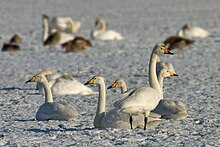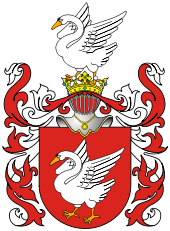
Etymology and terminology
The word swan is derived from Old English swan, akin to the German Schwan and Dutch zwaan and Swedish svan, in turn derived from Indo-European root *swen (to sound, to sing).[1] Young swans are known as swanlings or as cygnets, from Greek κύκνος, kýknos and from the Latin word cygnus ("swan") and the Old French suffix -et ("little"). An adult male is a cob, from Middle English cobbe (leader of a group); an adult female is a pen.Description

An adult trumpeter swan in Jackson Hole, Wyoming
The Northern Hemisphere species of swan have pure white plumage but the Southern Hemisphere species are mixed black and white. The Australian black swan (Cygnus atratus) is completely black except for the white flight feathers on its wings; the chicks of black swans are light grey. The South American black-necked swan has a white body with a black neck.
The legs of swans are normally a dark blackish grey colour, except for the two South American species, which have pink legs. Bill colour varies: the four subarctic species have black bills with varying amounts of yellow, and all the others are patterned red and black. Although most birds generally do not have teeth, swans are known to be an exception to this, having small jagged 'teeth' as part of their beaks used for catching and eating fish. The mute swan and black-necked swan have a lump at the base of the bill on the upper mandible.[citation needed]
Distribution and movements
See also: List of Anseriformes by population

Whooper swans migrate from Iceland, Scandinavia, and Northern Russia to Europe, Central Asia, China, and Japan
Several species are migratory, either wholly or partly so. The mute swan is a partial migrant, being resident over areas of Western Europe but wholly migratory in Eastern Europe and Asia. The whooper swan and tundra swan are wholly migratory, and the trumpeter swans are almost entirely migratory.[2] There is some evidence that the black-necked swan is migratory over part of its range, but detailed studies have not established whether these movements are long or short range migration.[3]
Behaviour
Swans feed in the water and on land. They are almost entirely herbivorous, although they may eat small amounts of aquatic animals. In the water food is obtained by up-ending or dabbling, and their diet is composed of the roots, tubers, stems and leaves of aquatic and submerged plants.[2]Although swans only reach sexual maturity between 4 and 7 years of age, they can form socially monogamous pair bonds from as early as 20 months that last for many years,[4] and in some cases these can last for life.[5] The lifespan of the mute swan is often over 10 years, and sometimes over 20, whereas the black-necked swan survives for less than a decade in captivity.[6] These bonds are maintained year round, even in gregarious and migratory species like the tundra swan, which congregate in large flocks in the wintering grounds.[7] The nest is on the ground near water and about a metre across. Unlike many other ducks and geese the male helps with the nest construction. Average egg size (for the mute swan) is 113×74 mm, weighing 340 g, in a clutch size of 4 to 7, and an incubation period of 34–45 days.[8] With the exception of the whistling ducks they are the only anatids where the males aid in incubating the eggs.
Swans are known to aggressively protect their nests. One man was suspected to have drowned in such an attack.[9][10]
Systematics and evolution

Black-necked swan at WWT London Wetland Centre

Mute swan on Lake Bled
Species
Genus Cygnus- Subgenus Cygnus
- Mute swan, Cygnus olor, is a Eurasian species that occurs at lower latitudes than whooper swan and Bewick's swan across Europe into southern Russia, China and the Russian Maritimes. Recent fossil records, according to the British Ornithological Union, show Cygnus olor is among the oldest bird species still extant and it has been upgraded to "native" status in several European countries, since this bird has been found in fossil and bog specimens dating back thousands of years. Common temperate Eurasian species, often semi-domesticated descendants of domestic flocks, are naturalized in the United States and elsewhere.
- Subgenus Chenopis
- Black swan, Cygnus atratus of Australia, and introduced in New Zealand
- †New Zealand swan, Cygnus atratus sumnerensis, an extinct subspecies of the black swan from New Zealand and the Chatham Islands
- Black swan, Cygnus atratus of Australia, and introduced in New Zealand
- Subgenus Sthenelides
- Black-necked swan, Cygnus melancoryphus of South America
- Subgenus Olor
- Whooper swan, Cygnus cygnus breeds in Iceland and subarctic Europe and Asia, migrating to temperate Europe and Asia in winter
- Trumpeter swan, Cygnus buccinator is the largest North American swan. Very similar to the whooper swan (and sometimes treated as a subspecies of it), it was hunted almost to extinction but has since recovered
- Tundra swan, Cygnus columbianus is a small swan that breeds on the North American tundra, further north than the trumpeter swan. It winters in the USA.
- Bewick's swan, Cygnus (columbianus) bewickii is the Eurasian form that migrates from Arctic Russia to western Europe and eastern Asia (China, Japan) in winter. It is often considered a subspecies of C. columbianus, creating the species tundra swan.
The supposed fossil swans "Cygnus" bilinicus and "Cygnus" herrenthalsi were, respectively, a stork and some large bird of unknown affinity (due to the bad state of preservation of the referred material). Anser atavus is sometimes placed in Cygnus.
The coscoroba swan (Coscoroba coscoroba) from South America, the only species of its genus, is apparently not a true swan. Its phylogenetic position is not fully resolved; it is in some aspects more similar to geese and shelducks.
In culture
See also: Black Swan emblems and popular culture, Black swan (disambiguation), The Swan of Tuonela and Swan upping
Many of the cultural aspects refer to the mute swan of Europe. Perhaps the best known story about a swan is "The Ugly Duckling"
fairytale. Swans are often a symbol of love or fidelity because of
their long-lasting, apparently monogamous relationships. See the famous
swan-related operas Lohengrin and Parsifal. Swan meat was regarded as a luxury food in England in the reign of Elizabeth I.
A recipe for baked swan survives from that time: "To bake a Swan Scald
it and take out the bones, and parboil it, then season it very well with
Pepper, Salt and Ginger, then lard it, and put it in a deep Coffin of
Rye Paste with store of Butter, close it and bake it very well, and when
it is baked, fill up the Vent-hole with melted Butter, and so keep it;
serve it in as you do the Beef-Pie."[12]
A swan depicted on an Irish commemorative coin in celebration of its EU presidency.

"Łabędź" (Polish for "Swan") is a Polish/Lithuanian coat of arms which was used by many Polish szlachta and Lithuanian Bajorai (noble) families under the Polish-Lithuanian Commonwealth. The variant here given is the coat-of-arms of writer Henryk Sienkiewicz's family.
The Irish legend of the Children of Lir is about a stepmother transforming her children into swans for 900 years. In the legend The Wooing of Etain, the king of the Sidhe (subterranean-dwelling, supernatural beings) transforms himself and the most beautiful woman in Ireland, Etain, into swans to escape from the king of Ireland and Ireland's armies. The swan has recently been depicted on an Irish commemorative coin.
Swans are also present in Irish literature in the poetry of W.B. Yeats. "The Wild Swans at Coole" has a heavy focus on the mesmerising characteristics of the swan. Yeats also recounts the myth of Leda and the Swan in the poem of the same name.
In Norse mythology, there are two swans that drink from the sacred Well of Urd in the realm of Asgard, home of the gods. According to the Prose Edda, the water of this well is so pure and holy that all things that touch it turn white, including this original pair of swans and all others descended from them. The poem Volundarkvida, or the Lay of Volund, part of the Poetic Edda, also features swan maidens.
In the Finnish epic Kalevala, a swan lives in the Tuoni river located in Tuonela, the underworld realm of the dead. According to the story, whoever killed a swan would perish as well. Jean Sibelius composed the Lemminkäinen Suite based on Kalevala, with the second piece entitled Swan of Tuonela (Tuonelan joutsen). Today, five flying swans are the symbol of the Nordic Countries and the whooper swan (Cygnus cygnus) is the national bird of Finland.
French satirist François Rabelais wrote in Gargantua and Pantagruel that a swan's neck was the best toilet paper he had encountered.
A swan is one of the attributes of St Hugh of Lincoln based on the story of a swan who was devoted to him.
Swans are revered in Hinduism, and are compared to saintly persons whose chief characteristic is to be in the world without getting attached to it, just as a swan's feather does not get wet although it is in water. The Sanskrit word for swan is hamsa or hansa, and the "Raja Hansa" or the Royal Swan is the vehicle of Goddess Saraswati, and symbolises the "Sattwa Guna" or purity par excellence. The swan if offered a mixture of milk and water, is said to be able to drink the milk alone. Therefore Goddess Saraswati the goddess of knowledge is seen riding the swan because the swan thus symbolizes "Viveka" i.e. prudence and discrimination between the good and the bad or between the eternal and the transient. This is taken as a great quality, as shown by this Sanskrit verse:
|
|

It is mentioned several times in the Vedic literature, and persons who have attained great spiritual capabilities are sometimes called Paramahamsa ("Supreme Swan") on account of their spiritual grace and ability to travel between various spiritual worlds. In the Vedas, swans are said to reside in the summer on Lake Manasarovar and migrate to Indian lakes for the winter. They're believed to possess some powers such as the ability to eat pearls.



.jpg)

No comments:
Post a Comment
Note: Only a member of this blog may post a comment.